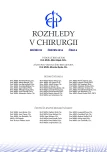Management of acute postoperative pain following thoracotomy – state of the art
Authors:
J. Matek 1; P. Michálek 2; S. Trča 1; Z. Krška 1
Authors‘ workplace:
I. Chirurgická klinika 1. LF Univerzity Karlovy a VFN v Praze
přednosta: prof. MUDr. Z. Krška, CSc.
1; Klinika anestezie, resuscitace a intenzivní medicíny 1. LF Univerzity Karlovy a VFN v Praze
přednosta: doc. MUDr. M. Stříteský, CSc.
2
Published in:
Rozhl. Chir., 2016, roč. 95, č. 6, s. 217-221.
Category:
Review
Overview
Postoperative pain management is an important part of complex perioperative care in patients undergoing thoracotomy, irrespective of the procedure type. Adequate pain relief leads to early mobilisation, improves respiratory functions and decreases global stress response. Thus, good perioperative pain management significantly reduces postoperative complications. Currently, numerous analgesic methods are available for the management of acute postthoracotomy pain including patient- or nurse-controlled systemic administration of analgesics, infiltration with local anaesthetics, intrapleural or intercostal nerve blockades and neuroaxial blocks (paravertebral, intrathecal, epidural). The aim of this review is to analyze the currently used methods in postthoracotomy pain management, their benefits in the light of current guidelines, and potential risks.
Key words:
thoracotomy – chest surgery − analgesia
Sources
1. Sabanathan S, Eng J, Mearns AJ. Alterations in respiratory mechanics following thoracotomy. J R Coll Surg Edinb 1990;35:144−50.
2. Davies RG, Myles PS, Graham JM. A comparison of the analgesic efficacy and side-effects of paravertebral vs. epidural blockade for thoracotomy: a systematic review and meta-analysis of randomized trials. Br J Anaesth 2006;96:418−26.
3. Kianfar A, Shadvar K, Mahoori A, et al. Pain after cardiac surgery. Crit Care 2007;11;429.
4. Mueller XM, Tinguely F, Tevaearai HT, et al. Pain location, distribution and intensity after cardiac surgery. Chest 2000;20;391−6.
5. Wallace AM, Wallace MS. Post-mastectomy and postthoracotomy pain. Anesthesiol Clin North Am 1997;15:353−70.
6. Perttunen K, Tasmuth T, Kalso E. Chronic pain after thoracic surgery: a follow-up study. Acta Anaesthesiol Scand 1999;43:563−7.
7. Imani F. Postooperative pain management. Anesth Pain 2011;1:6−7.
8. Pai A, Heining M. Ketamine. Cont Ed Anaesth Crit Care Pain 2007;7:59−63.
9. Dich-Nielsen JO, Svendsen LB, Berhelsen P. Intramuscular low-dose ketamine versus pethidine for postoperative pain treatment after thoracic surgery. Acta Anaesthesiol Scand 1992;36:583−7.
10. Joshi GP, Bonnet F, Shah R, et al. A systemic review of randomized trials evaluating regional techniques for postthoracotomy analgesia. Anesth Analg. 2008;107:1026−40.
11. Scott LJ, Perry Cm. Tramadol: a review of its use in perioperative pain. Drugs 2000;60;139−76.
12. De Cosmo G, Federico B, Sessa F, et al. Postoperative analgesia in thoracic surgery: a comparison between continuous paravertebral nerve block and continuous incisional infusion with OnQ pain relief system. J Anesth Clin Res 2012;4:279.
13. Strohbuecker B, Mayer H, Evers GC, et al. Pain prevalence in hospitalized patients in a German university teaching hospital. J Pain Symptom Manage 2005;29:496−506.
14. Kanazi GE, Ayoub CM, Aouad M, et al. Subpleural block is less effective than thoracic epidural analgesia for post-thoracotomy pain: a randomised controlled study. Eur J Anaesthesiol 2012;29:186−91.
15. Kalso E, Mennander S, Tasmuth T, et al. Chronic poststernotomy pain. Acta Anaesthesiol Scand 2001;45;935−9.
16. Chan VW, Chung F, Cheng DC, et al. Analgesic and pulmonary effects of continuous intercostal nerve block following thoracotomy. Can J Anaesth 1991;38;733−9.
17. Neustein SM, Cohen E. Intrathecal morphine during thoracotomy, Part II: Effect on postoperative meperidine requirements and pulmonary fiction tests. J Cardiothorac Vasc Anesth 1993;7;157−9.
18. Horlocker TT. Regional anaesthesia in the patient receiving antithrombotic and antiplatelet therapy. Br J Anaesth 2011;107:i96−i106.
19. McLeod GA, Davies HT, Munnoch N, et al. Postoperative pain relief using thoracic epidural analgesia: outstanding success and disappointing failures. Anaesthesia 2001;56:75−81.
20. Graf BM, Abraham I, Eberbach N, et al. Differences in cardiotoxicity of bupivacaine and ropivacaine are the result of physicochemical and stereoselective properties. Anesthesiology 2002;96:1427−34.
21. Landau R, Schiffer E, Morales M, et al. The dose-sparing effect of clonidine added to repivacaine for labor epidural analgesia. Anaesth Analg 2002;95;728−34.
22. Roelants F, Lavand PM, Mercier-Fuzier V. Epidural administration of neostigmine and clonidine to induce labor analgesia: evaluation of efficacy and local anesthetic-sparing effect. Anesthesiology 2005;102;1205−10.
23. Davies RG, Myles PS, Graham JM. A comparison of the analgesic efficacy and side-effects of paravertebral vs. epidural blockade for thoracotomy – a systematic review and meta-analysis of randomized trials. Br J Anaesth 2006;96:418–26.
24. Vymazal T, Michálek P. Anestezie a pooperační péče v hrudní chirurgii, Praha, Mladá Fronta 2016.
Labels
Surgery Orthopaedics Trauma surgeryArticle was published in
Perspectives in Surgery

2016 Issue 6
Most read in this issue
- Laparoscopic resection rectopexy in the treatment of obstructive defecation syndrome
- Different techniques of vessel reconstruction in kidney transplantation −10-years experiences
- Management of acute postoperative pain following thoracotomy – state of the art
- Videothoracoscopic excision of mediastinal parathyroid adenoma in primary hyperparathyroidism
